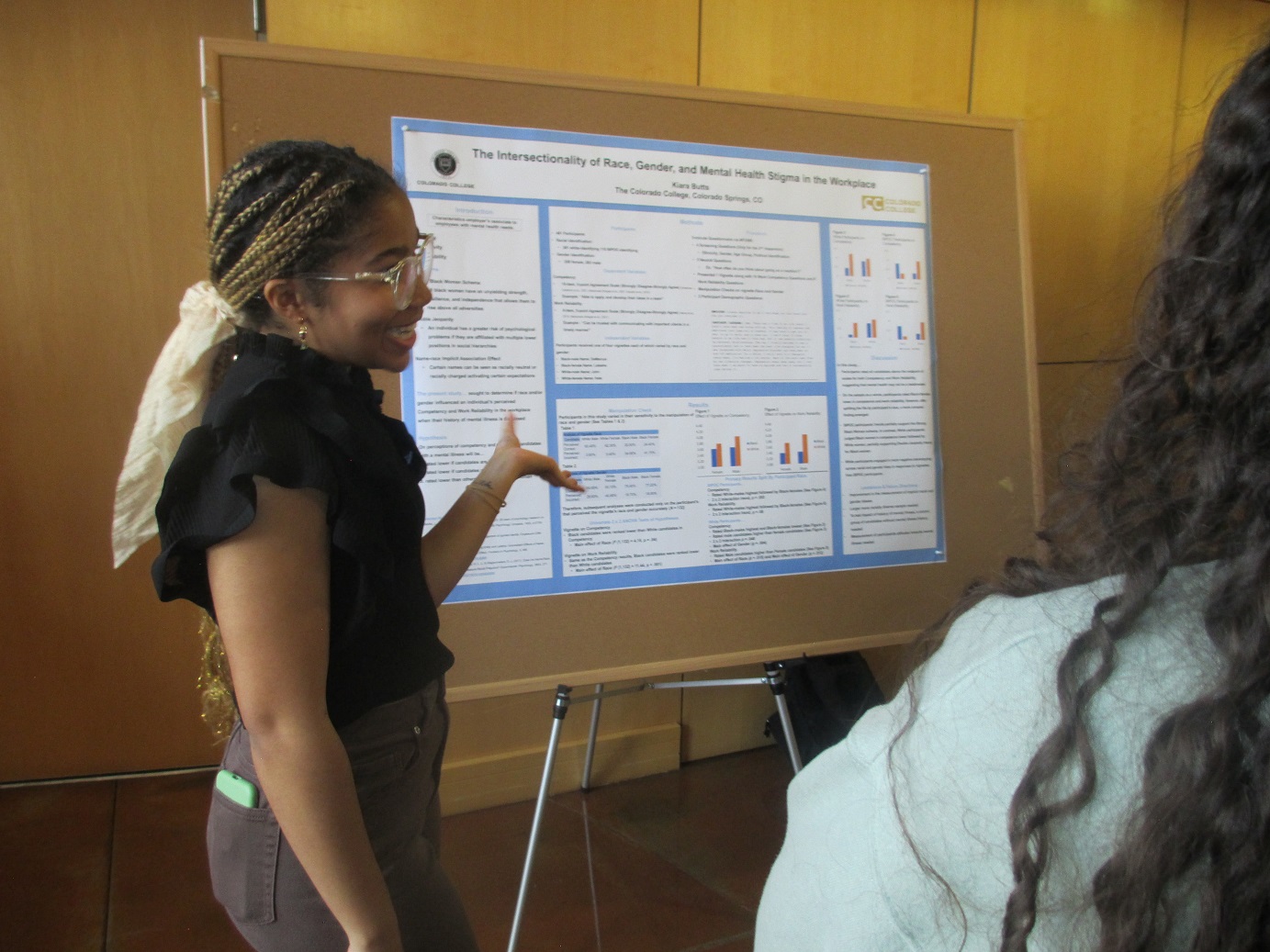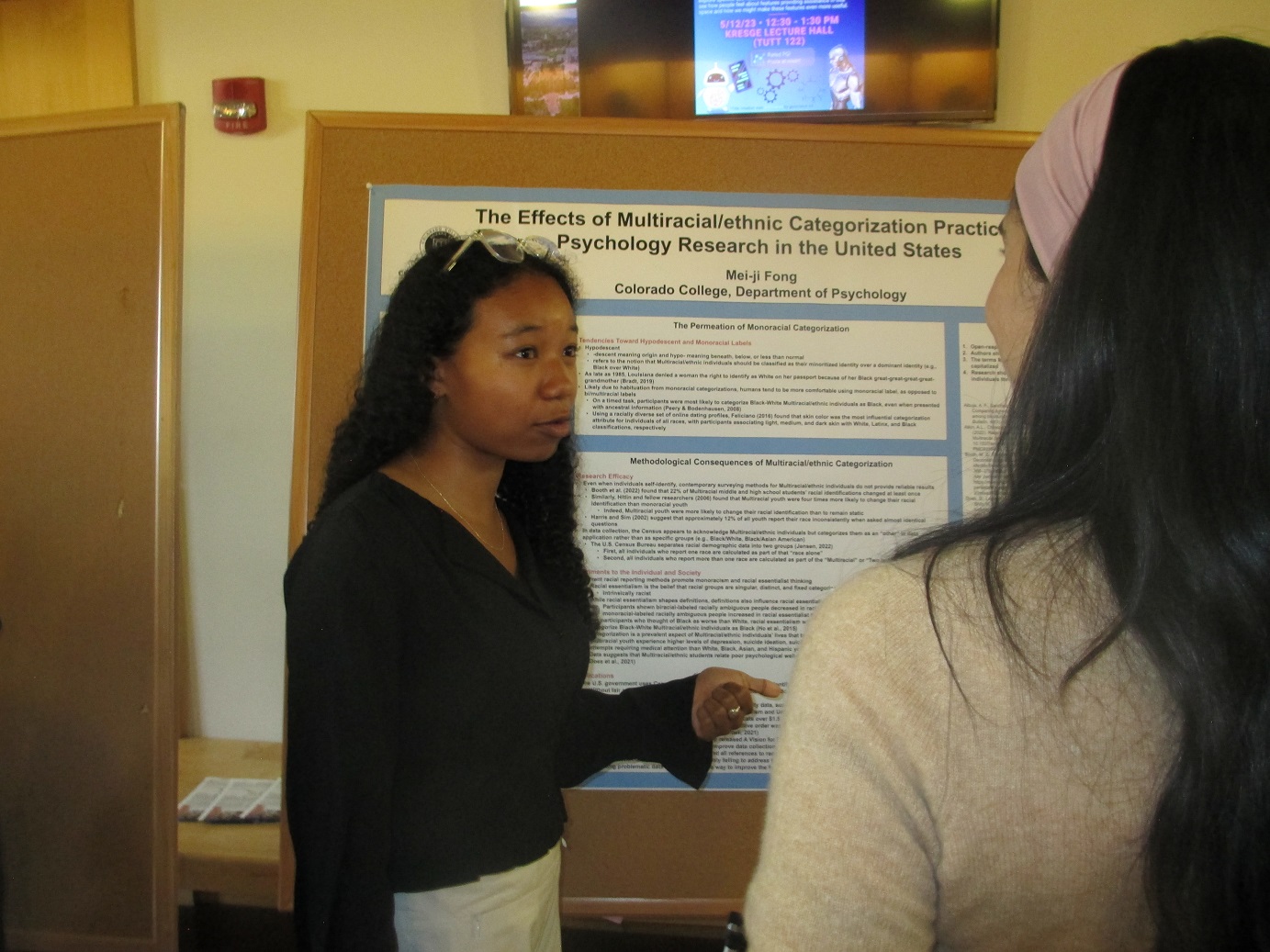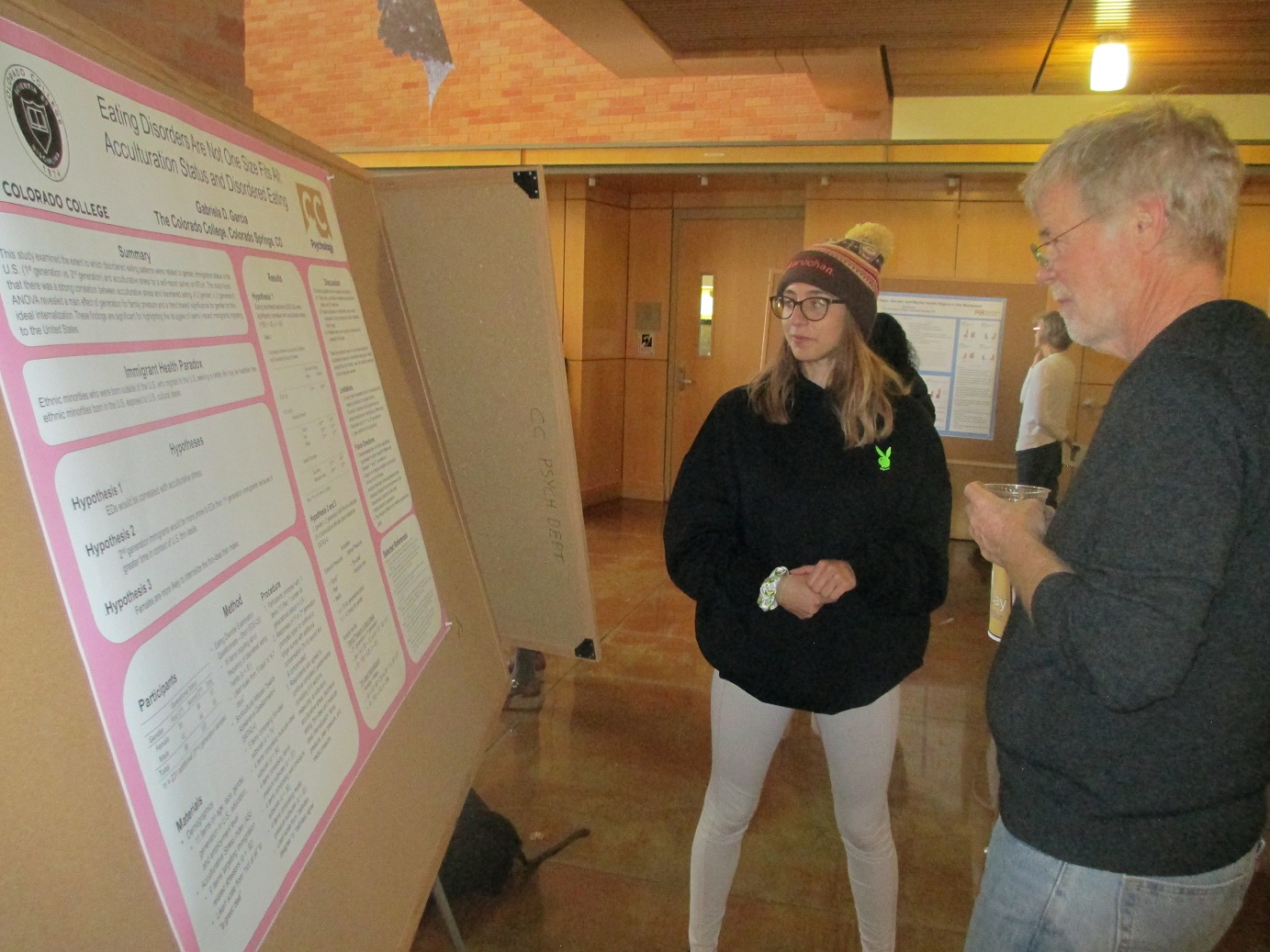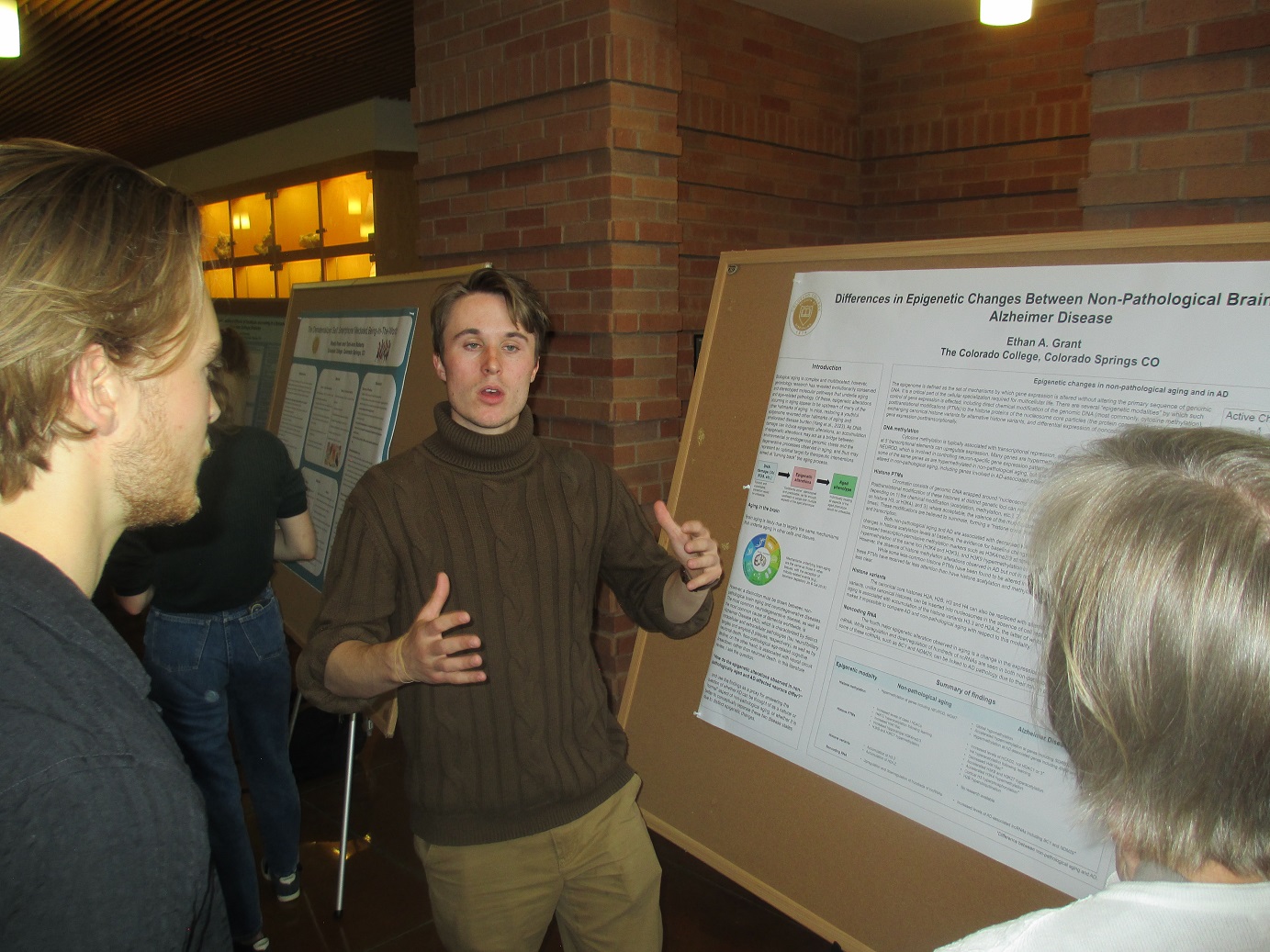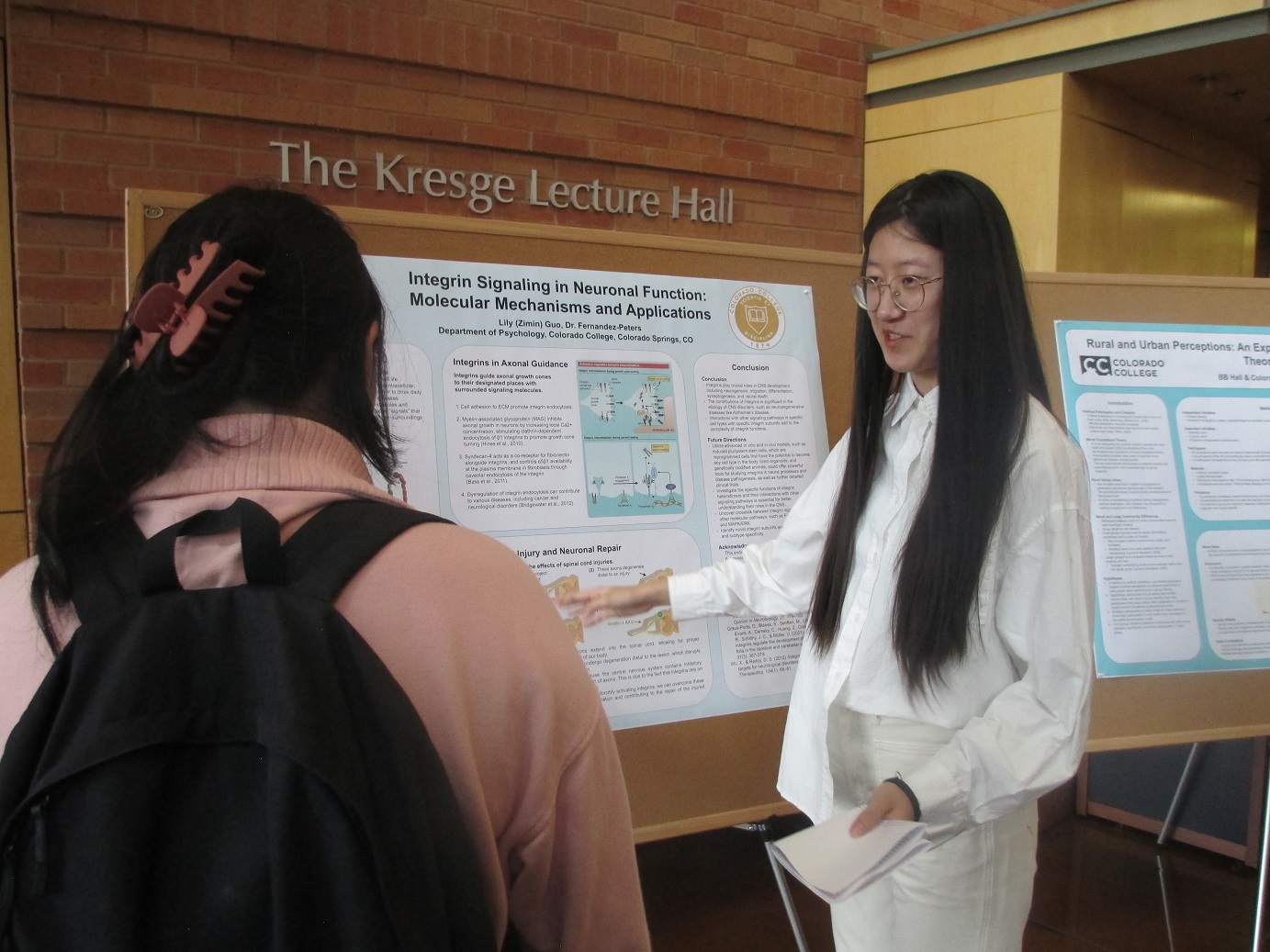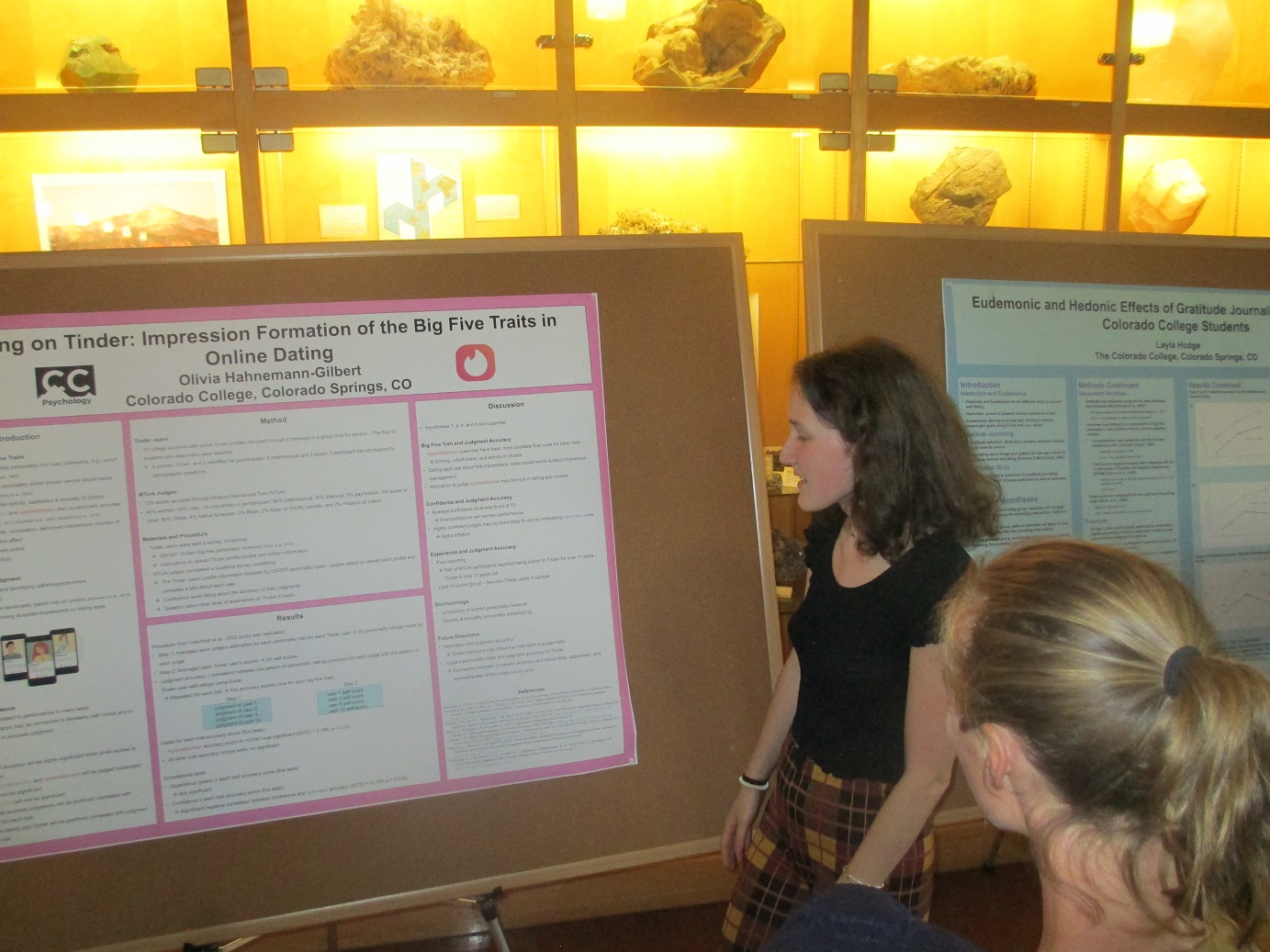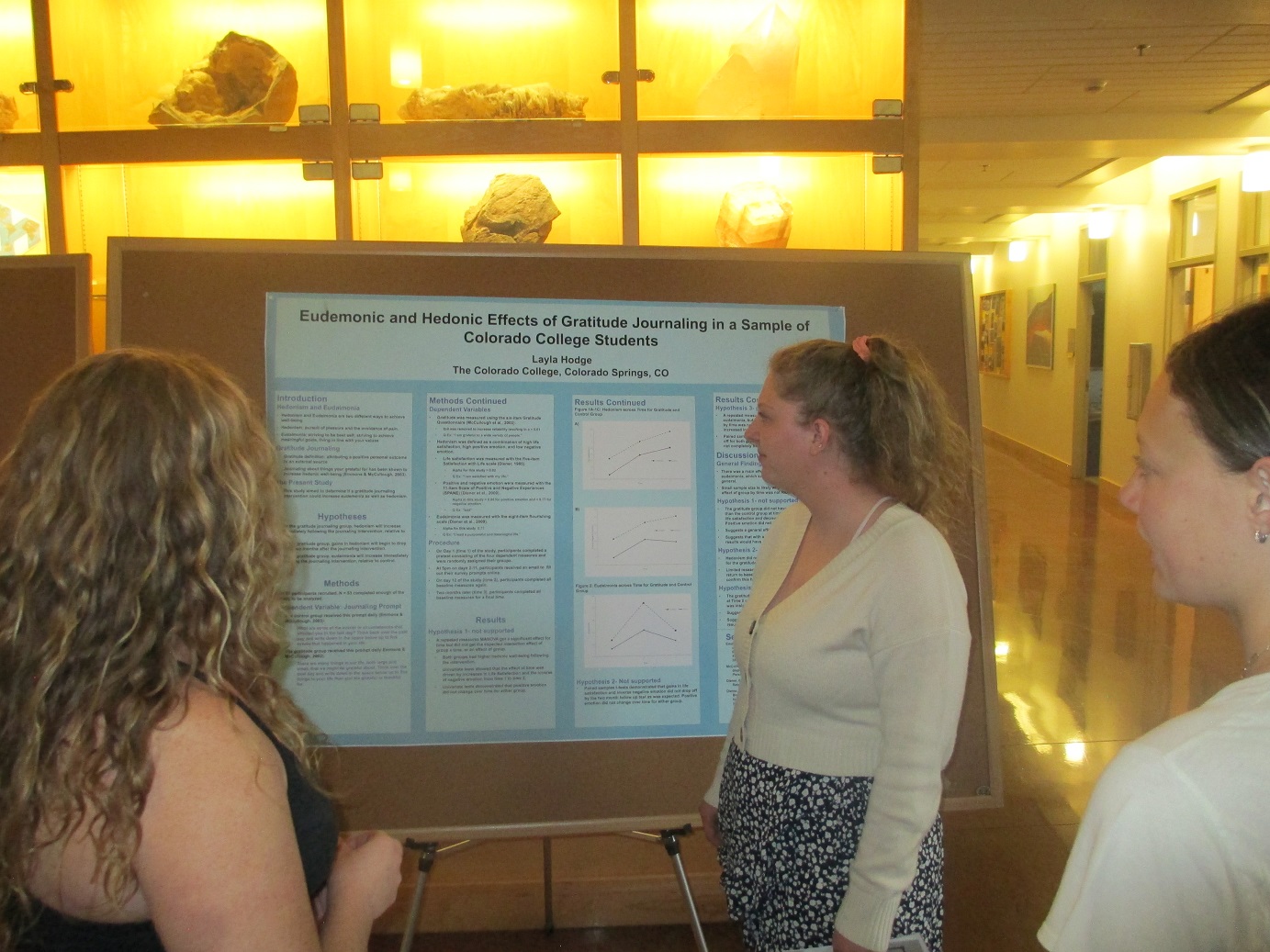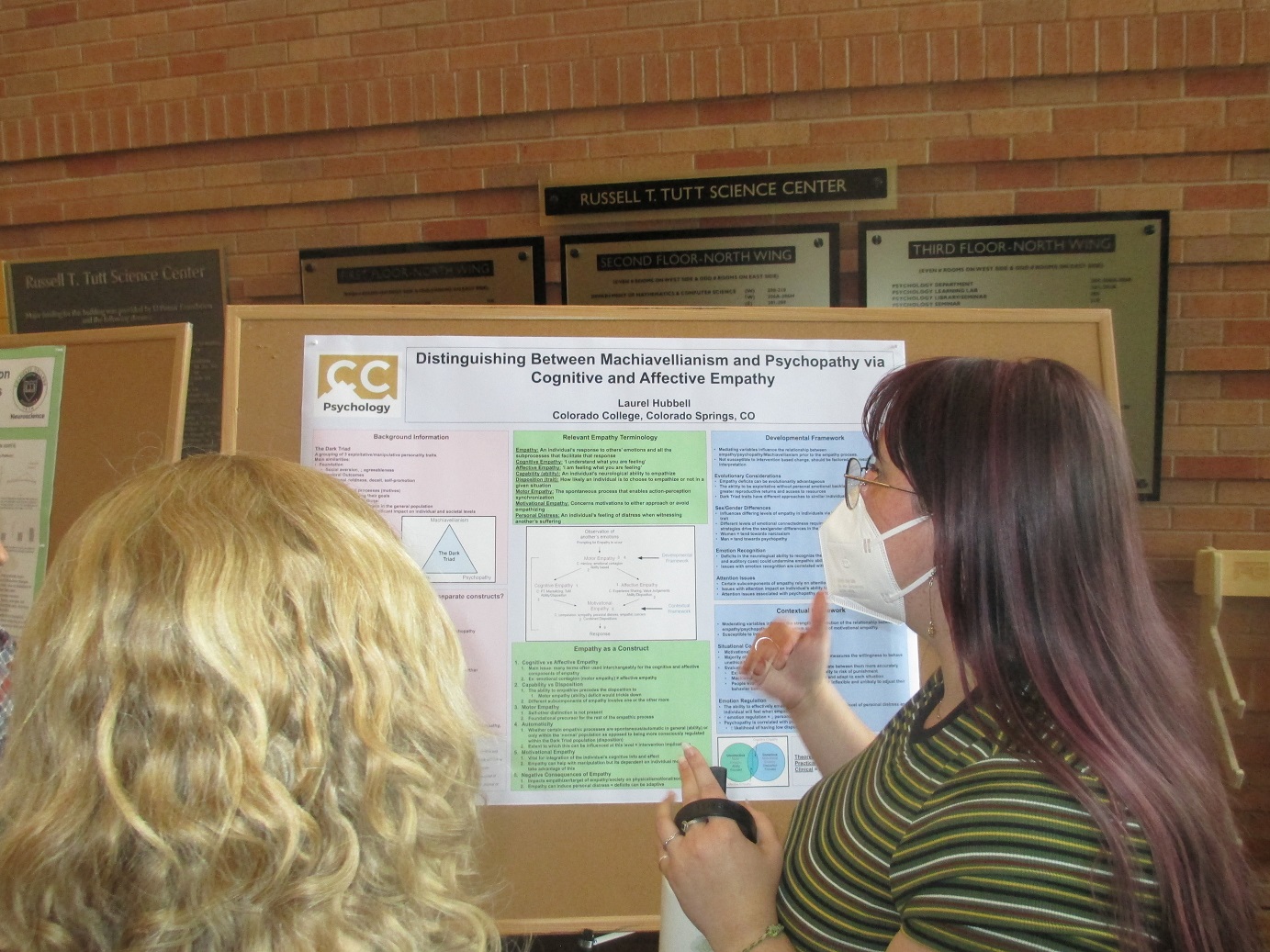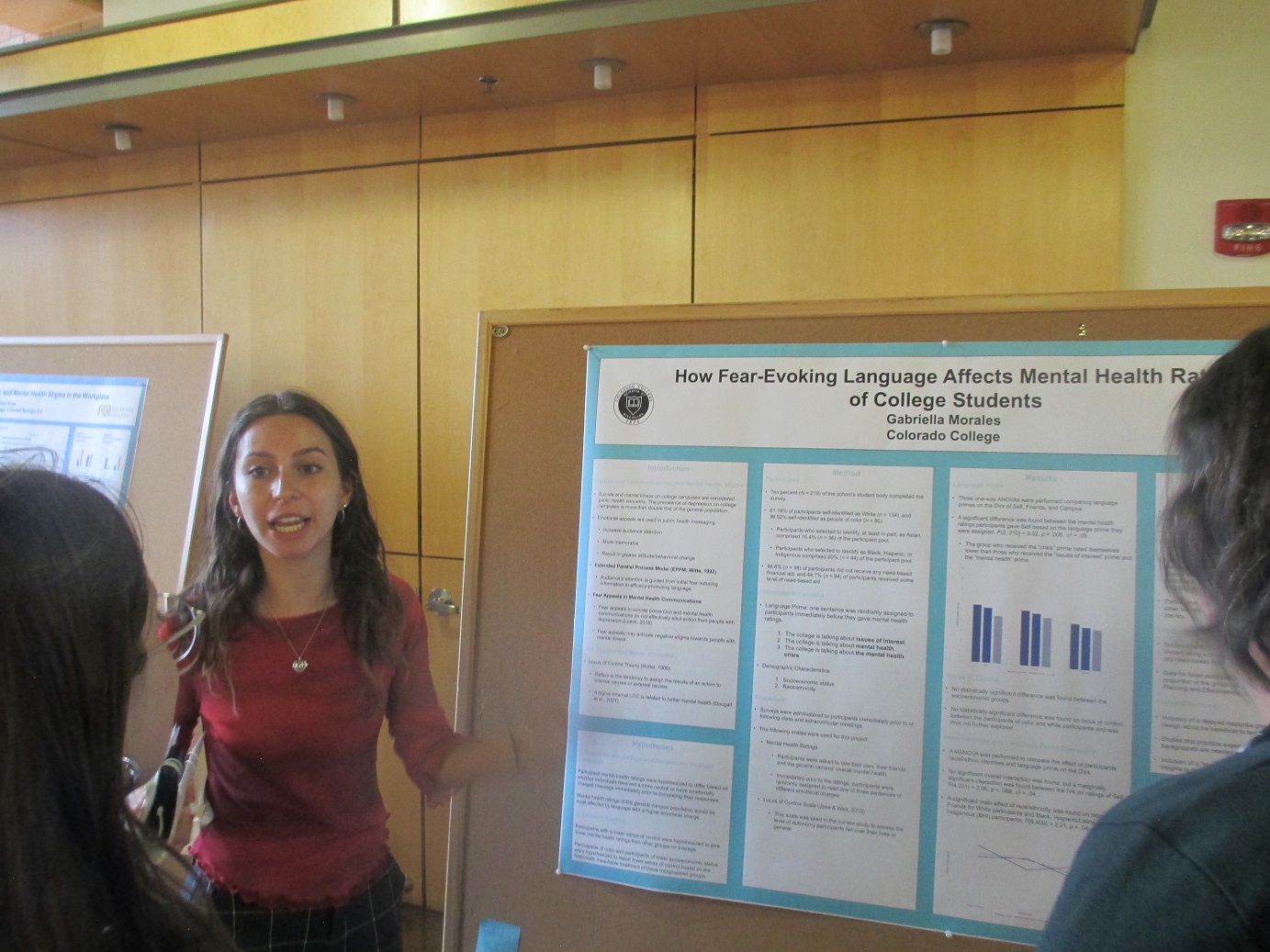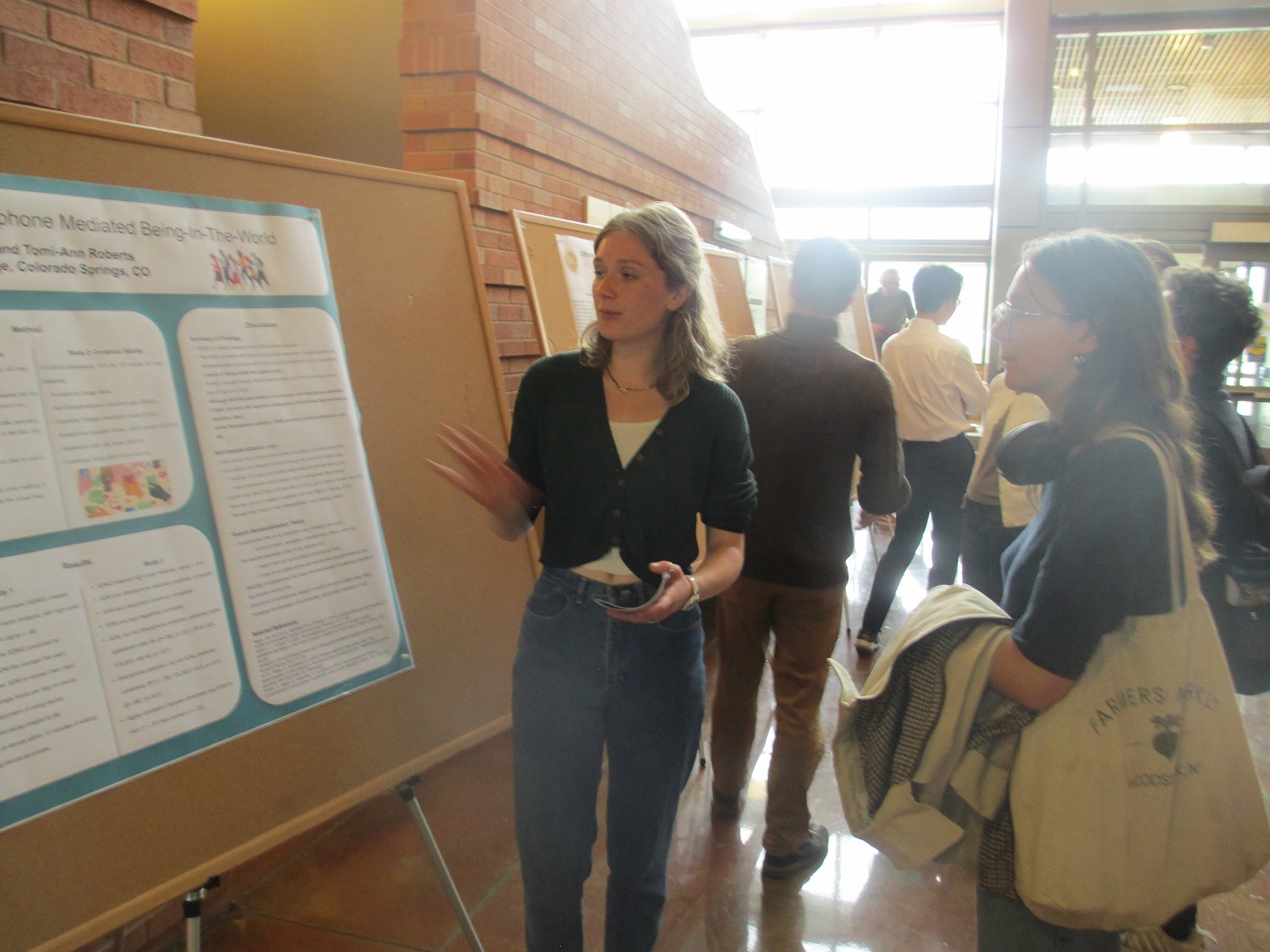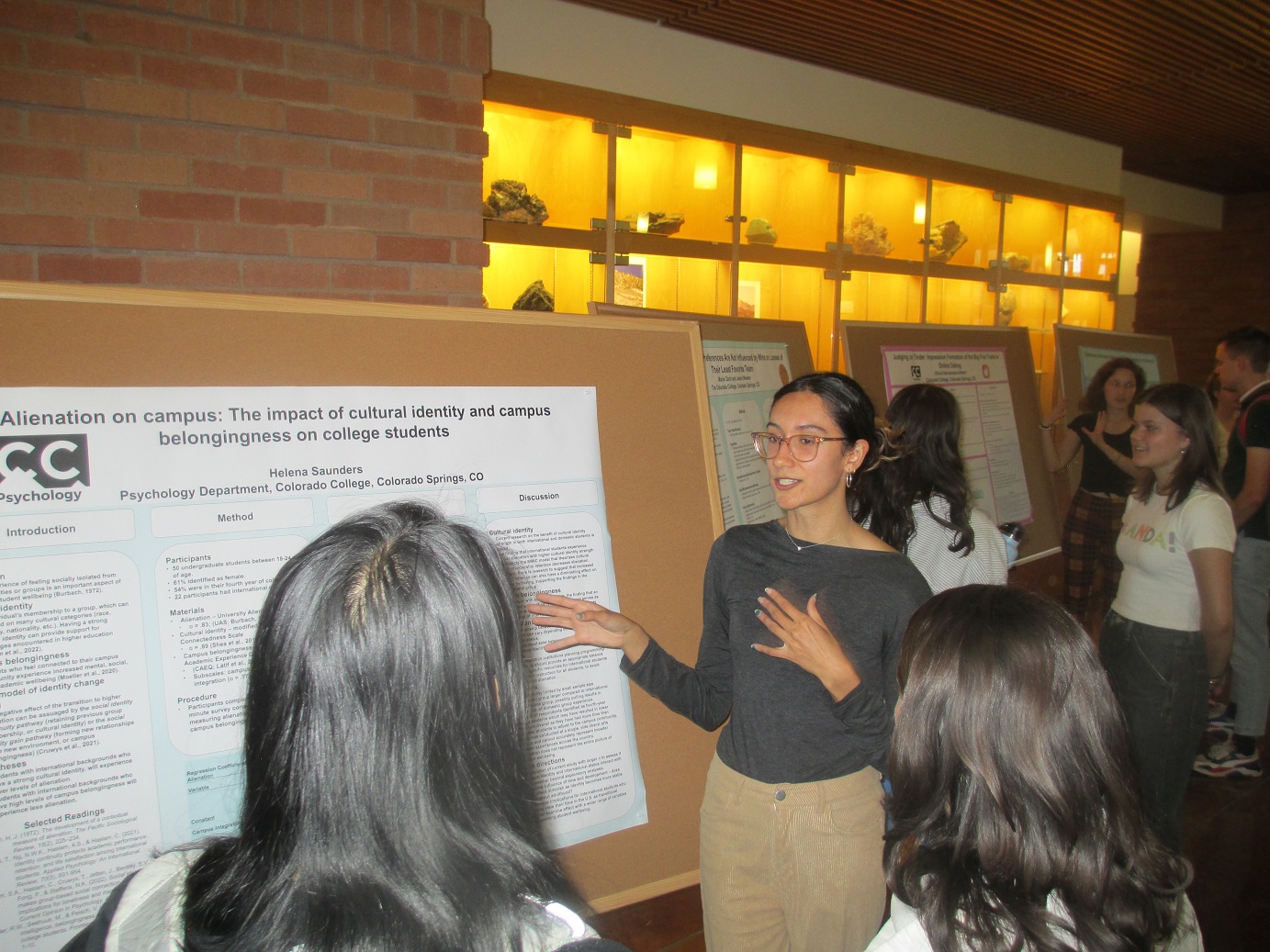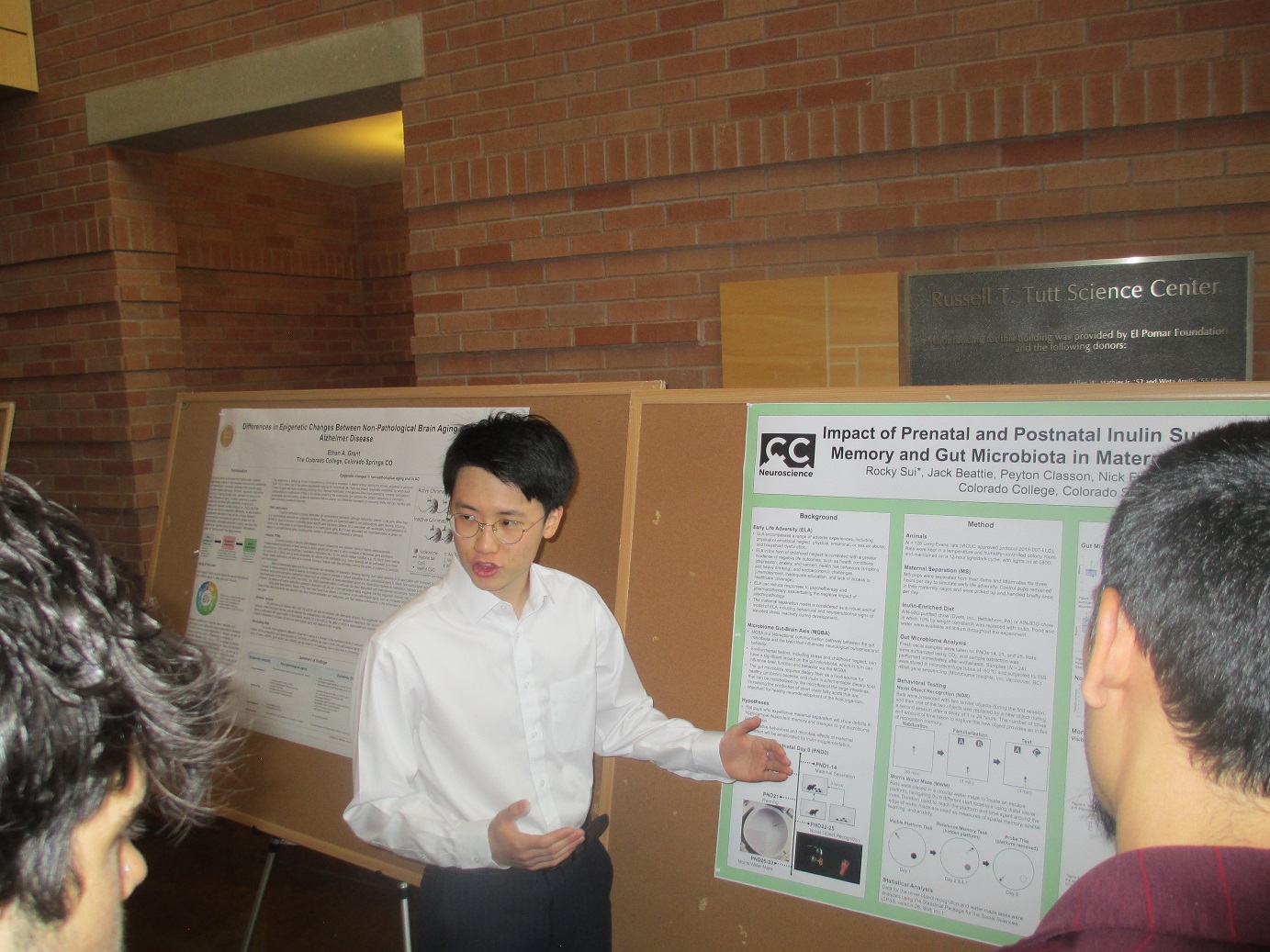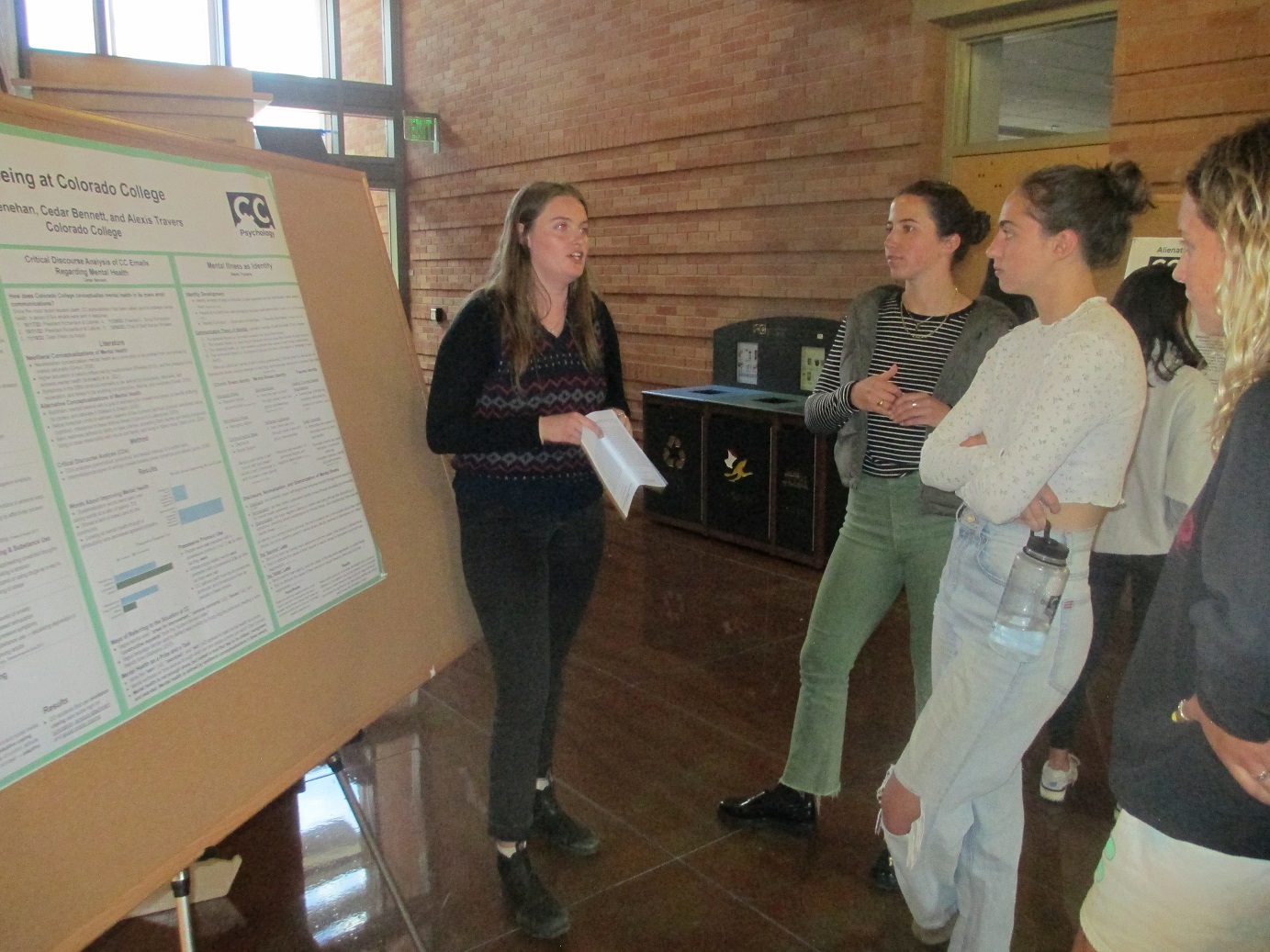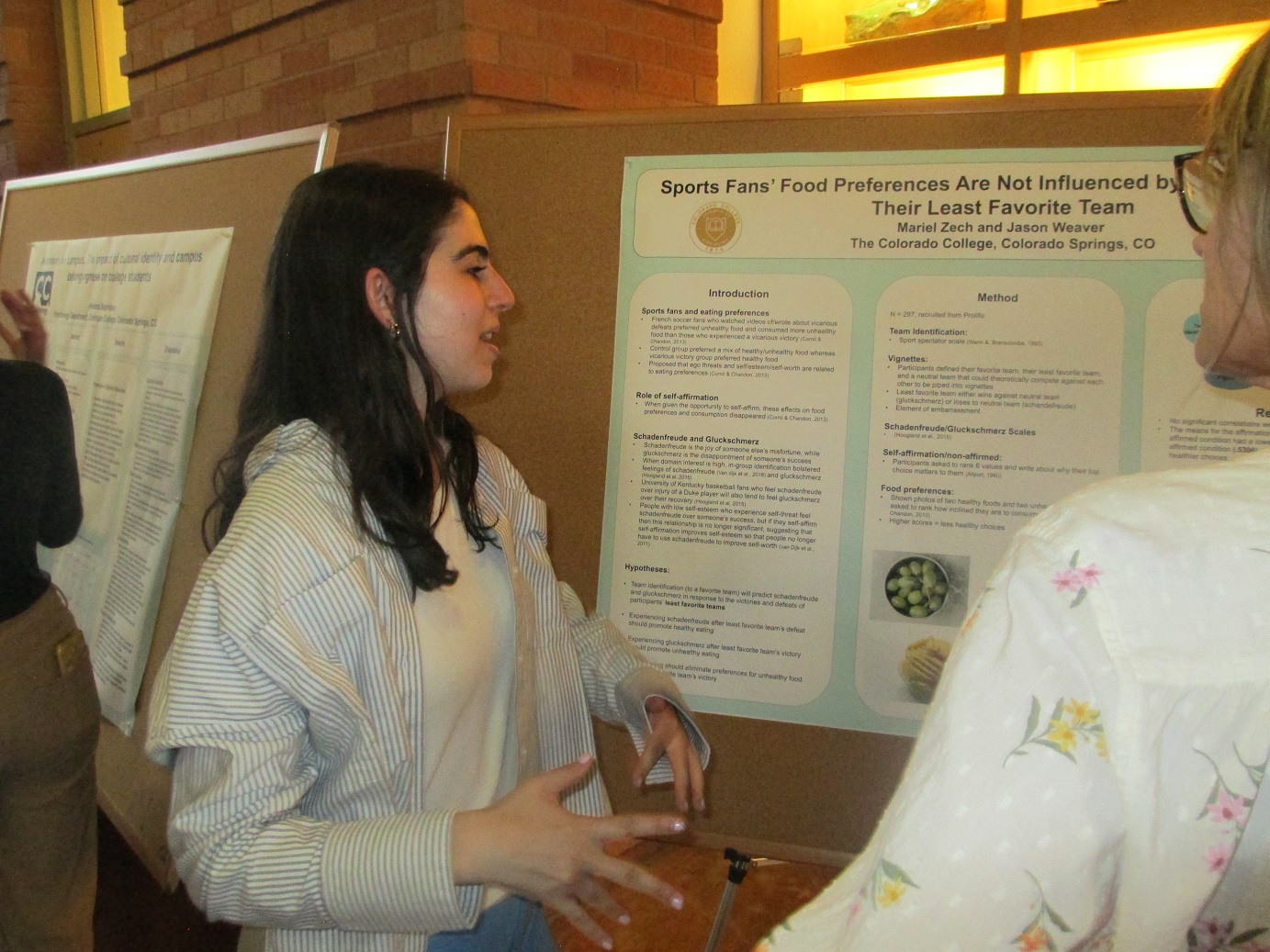Poster Day 2023
Psychology
Advisor: Kristi Erdal
Critical Discourse Analysis of CC Mental Health Emails: An analysis of data from the Well-being at Colorado College Survey-based Research Study
This project evaluated the language used in five emails from the Colorado College administration to better understand how mental health is conceptualized. Dominant neoliberal conceptualizations of mental health and indigenous and Buddhist conceptualizations were compared and contrasted. Based on a grammatical, syntactical, and linguistic analysis of the Colorado College administration’s emails addressing mental health, it becomes clear that Colorado College leans heavily into neoliberal conceptualizations of mental health.
Psychology
Advisor: Tricia Waters
The Intersectionality of Race, Gender, and Mental Health Stigma in the Workplace
Despite the growth in mental health research, stigma persists. Stereotypes like fragility, sensitivity, and unreliability cause employers to discriminate against people with mental health needs. Gender and race are two characteristics that have also been shown to be components of discrimination in the workplace. The intersectionality of race and gender has brought about, such as the Strong Black woman schema, that harms Black women's health and the “double jeopardy” label that has defined a person’s experience when they are at the crossroads of multiple lower groups in a social hierarchy. The present study sought to determine whether race and/or gender influence an individual's perceived competency and reliability in the workplace when their history of mental health has been publicized. Four hundred and one participants were randomly assigned to one of four vignettes that varied by name (gender and race) of the character. Then answered questions on how competent and reliable the character would be in a job. While there was no significant interaction between race and gender on competency and work reliability, there was a trend towards perceiving females as less competent than males. Gender was more easily associated with a name than race. Participants did not accurately identify the candidate's race. The complexities of testing implicit biases and attitudes toward mental illness should be the focus of future research.
Psychology
Advisor: Kristi Erdal
The Effects of Multiracial/ethnic Categorization Practice on Psychology Research in the United States
In the United States, Multiracial/ethnic individuals are the fastest-growing racial group (Atkin et al., 2022). However, Multiracial/ethnic categorization often ignores the varied identities and individual experiences of the people grouped within it. The vagary of “Multiracial” as a category often obscures the disparate experiences of Multiracial/ethnic individuals. This paper will examine the consequences of the categorization of Multiracial/ethnic individuals in the United States, survey methods of such people, and the research outcomes potentially due to these methods. First, the paper will discuss conceptions of race. Next, a timeline of Multiracial/ethnic categorization and a review of literature on the impacts of Multiracial/ethnic categorization will be covered. The implications of surveying practices, such as their impact on resource distribution, political representation, and valuing monoracism and White centrality, will also be discussed. Finally, suggestions for future research and racial/ethnic demographic questions moving forward will be included.
Psychology
Advisor: Tricia Waters
Eating Disorders Are Not One Size Fits All: Acculturation Status and Disordered Eating
This study examined the extent to which disordered eating patterns were related to gender, immigration status (first generation vs. second generation) and acculturative stress. One hundred eighty-nine participants completed a self-report survey. This study found that there was a strong correlation between acculturative stress and disordered eating. A 2 (gender) x 2 (generation) ANOVA revealed a main effect for family pressure and a trend toward significance for thin-ideal internalization. These findings are significant to target the specific populations struggling, most after a (semi)recent migration to the United States.
Neuroscience
Advisor: Lori Driscoll
The Therapeutic Potential of Psychoplastogens for Treatment Resistant Depression
Major depressive disorder is a debilitating psychiatric condition with no universal treatment that enacts a large cost worldwide. A large proportion of people with major depressive disorder do not respond to available therapies and are deemed treatment resistant. Current antidepressants on the market were developed using the monoamine hypothesis of depression. However, this hypothesis may not fully capture the neurological basis of major depressive disorder. Newer theories suggest that major depressive disorder is a result of deficits in brain plasticity. Psychoplastogens, drugs that increase plasticity within the brain by inducing synaptogenesis, provide effective treatment for people with treatment resistant depression, and neural plasticity is thought to play a major role. Due to the subjective psychedelic effect that is associated with these drugs, however, the drugs are expensive and carry unwanted anxiogenic effects. To provide this treatment without causing problematic side effects, new drugs are being developed to promote plasticity without causing subjective psychedelic effects. The present paper evaluates the potential efficacy and practicality of these drugs by looking at metrics that have evaluated psychoplastogen efficacy in the past and assessing the application of these metrics to new drugs. Although substantial barriers must be overcome before non-hallucinogenic psychoplastogens are approved by regulatory bodies, preliminary data are promising. Regardless of the future of non-hallucinogenic psychoplastogen use, ongoing research should lead to increased knowledge and therefore efficacy of psychoplastogens.
Neuroscience
Advisor: Lori Driscoll
Differences in Epigenetic Changes Between Non-Pathological Brain Aging and Alzheimer Disease
Biological aging is associated with epigenetic alterations, or changes to the cellular mechanisms that regulate gene expression without altering the DNA sequence of the genome. These epigenetic alterations lead to dysregulation of gene expression and loss of identity in aging cells, including in neurons. Alzheimer Disease, likewise, is associated with epigenetic alterations; however, the epigenetic alterations observed in Alzheimer Disease are not universally the same as those observed in non-pathological brain aging. Although some epigenetic modalities, such as histone methylation, appear to involve similar changes in non-pathological brain aging and in Alzheimer Disease, other modalities, such as DNA methylation, histone acetylation and expression of noncoding RNA, manifest differently between the two conditions. These differences may prevent the development of broad-spectrum epigenetic-based therapeutics for non-pathological aging and Alzheimer Disease.
Neuroscience
Advisor: Marcela Fernandez-Peters
Integrin Signaling in Neuronal Function: Molecular Mechanisms and Applications
Integrins are transmembrane proteins that play essential roles in the development and function of the central nervous system, such as mediating cell adhesion by interacting with extracellular matrix proteins. This literature review aims to provide a comprehensive understanding of the role of integrins during the main stages of neural development, synaptic plasticity, and connectivity, as well as the potential of targeting integrin signaling for therapeutic benefits. Additionally, it highlights the importance of investigating integrin expression to develop diagnostic tools for various disorders.The research focuses on the function of the extensively researched β1 integrin subunits and other important subunits involved in specific developmental processes. By deepening the understanding of the complex roles integrins play in neural development, maintenance, and repair, this review elucidates the molecular mechanisms underlying CNS architecture and function. Further research should explore the potential of targeting integrin signaling for therapeutic benefits in neurodegenerative diseases, brain injuries, and tumor progression. Additionally, future studies should investigate the differences in integrin signaling between the CNS and PNS, and clarify the specific roles of individual integrin subunits in neural development. This comprehensive analysis will pave the way for the development of novel therapeutic targets and diagnostic tools for neurological disorders, highlighting the significance of integrins in both basic and clinical neuroscience.
Psychology
Advisor: Jason Weaver
Judging on Tinder: Impression Formation of the Big Five Traits in Online Dating
Impression formation is an ability that helps humans to survive and thrive (Haselton et al., 2013). This study investigated the capability to accurately judge other peoples’ Big Five personality traits over the dating app, Tinder. It also examined the judge’s level of experience on Tinder and confidence of judgments in relation to accuracy. I hypothesized that openness would be accurately judged, that extraversion, agreeableness, and conscientiousness may be judged moderately well, and that neuroticism would not be accurately judged. I predicted that Tinder experience and confidence in judgments would, respectively, be positively correlated to accuracy for all traits. I recruited 10 college seniors to complete a personality test, then upload the photos and written content from their Tinder profiles. 276 MTurk participants completed a personality test about each Tinder user, then answered questions about their confidence in their judgments, their experience with Tinder, and demographic information. The results showed significant accuracy for agreeableness only. A significant negative correlation was found between confidence and accuracy in judging openness. Other correlations and t-tests were not significant. This study indicates that agreeableness may be the easiest trait to judge over Tinder, and that overconfident judges may rely more heavily on Tinder openness cues.
Psychology
Advisor: Jason Weaver
Rural and Urban Perceptions: An Expansion upon Moral Foundations Theory
In a climate of increased polarization and hostility between political parties, examining the dynamics of different ingroups and outgroups is essential to understanding the social climate in which the modern world exists. The present study specifically assessed how geographic location, measured as population density, and political ideology impact perceptions of authority, ingroup identity, and cohesion. The loyalty/ betrayal and authority/ subversion scales from Graham et al.’s (2009) moral foundations theory study were used to measure perceptions of ingroup identity and authority. Participants were also asked how cohesive they thought their political party was. Partial hypothesis support was found and significant density effects were observed including positive correlations between population density and authority as well as population density and ingroup scores. Population density and political ideology were not significantly related thus supporting a foundational assumption that geographic location and political ideology diverge as constructs. Positive correlations between authority and ingroup scores raised questions surrounding how moral ideologies have changed in the last decade in a context of increased distrust in government systems (Pew Research Center, 2022). Avenues for future research include a further investigation of how urban and rural populations differ in their perceptions of cohesion when highly urban populations are better represented.
Psychology
Advisor: John Horner
The Effects of Gratitude Journaling on Eudaimonia and Hedonism in a College Population
There are two major philosophical views of how to achieve a good life: seeking pleasure and avoiding pain (hedonism) or striving to achieve meaningful goals throughout life (eudaimonia). Recent research has demonstrated that journaling about event’s one is grateful for has increased measures of hedonic well-being. This study further examines the relationship between gratitude journaling, hedonism, and eudaimonia. Specifically, it investigates whether a gratitude journaling intervention can increase eudemonic measures of well-being as well as hedonic measures, and the time course of that intervention in a controlled study. Participants either journaled about things they are grateful for 10 days (gratitude group), or about the events of their day (control group). Measures of hedonism and eudaimonia were taking immediately before, after the journaling intervention, and two months after the journaling intervention. Both groups increased in hedonic and eudemonic well-being, indicating a general effect of journaling. However, results suggest that with a larger sample size, the gratitude group would have increased in well-being more than control.
Psychology
Advisor: Jason Weaver
Distinguishing Between Machiavellianism and Psychopathy via Cognitive and Affective Empathy
Empathy has been used as a tool to navigate the debate surrounding whether Machiavellianism and psychopathy are distinct constructs. Psychologists have historically examined empathy’s operationalization as a means of addressing difficulties within this area of research. In contrast, little attention has been paid to conceptualization concerns that typically precede operational ones. Current research into this topic is inconsistent. More time is spent on rectifying measurement concerns than on advancing this theoretical distinction. By taking a conceptual approach to this issue, these testing concerns can begin to be addressed from their foundation. A conceptual approach entails re-evaluation of empathy as a construct by means of exploring six key concepts within empathy (Cognitive versus Affective Empathy, Capability versus Disposition, Motor Empathy, Automaticity, Motivational Empathy, and the Negative Consequences of Empathy), and the exploration of the mediators and moderators of the relationship between empathy, Machiavellianism, and psychopathy. Mediators/moderators can be divided into two frameworks: Developmental and Contextual. Ultimately, this approach highlights important theoretical, clinical, and practical applications within the existing literature on the Dark Triad.
Psychology
Advisor: Kristi Erdal
The Implications of Using Fear-Evoking Language in Mental Health Communications
The mental health of college students is receiving national attention as mental illness affects students at higher rates than in years before (Lipson et al., 2022). While numerous reasons have been considered for this increasing prevalence, factors such as institutional communications and students’ senses of control have largely been neglected. In the current study, the effects of fear-based appeals in mental health communications were investigated. A comprehensive survey was administered to participants at a small liberal arts college. During the survey, participants were randomly assigned to read one of three statements of differing emotional charges regarding mental health, and then asked to give mental health ratings of Self, Friends, and Campus immediately after. It was hypothesized that students who received a fear-based appeal (i.e., “crisis” prime) would rate Campus mental health as significantly lower than groups who received more neutral appeals. Instead, participants who received the “crisis” prime rated their own mental health significantly lower than they did all other groups. Sense of control was assessed but not related to socioeconomic status or race/ethnicity. However, an interaction between race/ethnicity and language prime was found, with Asian participants rating Self and Friends lowest after receiving the more neutral “mental health” prime compared to White participants and Black, Hispanic and Indigenous (BHI) participants. BHI participants also rated Friends higher than did White participants. Overall, these findings reveal the problems related to using fear-based appeals in mental health communications and the necessity for culturally diverse sampling.
Psychology
Advisor: Tomi-Ann Roberts
The Dematerialized Self: Smartphone Mediated Being-In-The World
We live in a digital age; smartphones are our constant companions. To reflect this reality, we propose a novel phenomenological concept that articulates a smartphone mediated being-in-the-world. Through the affordances of smartphones, individuals may “dematerialize” from the material world to invest and immerse themselves deeply into their digital world. Our first study created the Self-Dematerialization Questionnaire (SDMQ), a reliable measure of trait self-dematerialization in individuals. Our second study established the construct validity of the SDMQ, which showed convergent validity with absorption. Results indicated that younger people, those with higher SES, and potentially women and politically conservative individuals, are higher in trait self-dematerialization (SDM). Regression analyses showed that, while both smartphone addiction (SA) and SDM negatively predict mindful attention awareness, these constructs have divergent validity. SA predicts loneliness, while SDM does not. Further, unlike SA, SDM predicts lower empathy and higher satisfaction with life.
Psychology
Advisor: Kristi Erdal
Coping Strategies: An analysis of data from the Well-being at Colorado College Survey-based Research Study
This project discusses the effects of adaptive (i.e., problem-focused coping, positive reappraisal, and social support) and maladaptive (i.e., emotion-focused coping, avoidant coping, and substance abuse coping) coping mechanisms on managing stress. Avoidance coping, a maladaptive coping strategy, was positively related to rumination, anxious attachment, and social media cravings.
Psychology
Advisor: Tricia Waters
Alienation on Campus: The Impact of Cultural Identity and Campus Belongingness on College Students
This study examined the relationship between alienation, cultural identity, and campus belongingness in students with international backgrounds as compared to domestic students. Participants (n = 50) responded to a 10-minute online survey that was comprised of scales measuring alienation, cultural identity, and campus belongingness. Participants also indicated their international experience or lack thereof through the survey. It was hypothesized that international students who had a strong cultural identity and increased campus belongingness would experience less alienation. However, results showed that respondents who had an international background and stronger cultural identity reported higher alienation, while domestic respondents with a stronger cultural identity indicated lower alienation. Increased campus belongingness had a mitigating effect on alienation for both groups. Given the increase in students with international backgrounds at college campuses across the United States, these findings provide suggestions for programming and seminars that promote campus belongingness. The study concludes with questions for future research into identity formation of students with international backgrounds and the impact of the trajectory of time on cultural identity and alienation.
Neuroscience
Advisor: Lori Driscoll
Impact of Prenatal and Postnatal Inulin Supplementation on Memory and Gut Microbiota in Maternally Separated Rats
Stressful experiences early in life, such as being neglected by caregivers, can influence mental health later in life, both directly and through impacting the health of the gastrointestinal tract. In rodent models, these stressful experiences, called early life adversity (ELA), are commonly modeled through maternal separation, in which newborn pups are isolated from their dam during the first two weeks of life. The aim of the current study is to determine whether prenatal and postnatal dietary supplementation with prebiotic inulin fiber could mitigate the negative impacts of ELA on memory. Long-Evans Dams were randomly assigned to purified control or 10% inulin-enriched chow on the last week of gestation. At birth, litters were maintained on the control or inulin chow to which their dams were assigned. Half of the litters from each diet group were randomly assigned to the maternal separation condition, in which each pup was isolated from its dam for three hours per day from postnatal days 1 to 14. After weaning, rats were tested in object recognition and Morris water maze tasks for recognition and spatial memory. Six pups from each treatment group were euthanized and fresh cecal samples were taken on PNDs 14, 21, and 28 for 16S ribosomal DNA analysis of bacterial composition and diversity. Results indicate that maternal separation did not consistently induce behavioral deficits. Inulin supplementation decreased fear and anxiety behavior and increased navigation speed and distance in the Morris water maze, regardless of treatment, but it did not substantially impact gut microbiota. Future studies should employ more rigorous models of ELA to induce behavioral deficits and microbial alterations.
Psychology
Advisor: Kristi Erdal
Mental Illness as Identity: An analysis of data from the Well-being at Colorado College Survey-based Research Study
This project focuses on identity development, identity reconstruction, attribution styles, and communicating identity. Literature on the development of new identities formed through experiences of chronic pain, mental illness, and trauma are discussed to determine whether there is a connection between attributional styles and a strong identification with mental illness. Mental illness identity did not correlate with attribution style. A significant difference in “controllability” (both in the positive and negative scenarios) was also found between those who identified as having a mental illness and those who did not. Additionally, chi-squares on the Illness condition and race showed that significantly more white students identified with having a mental illness, proportionally, than did students of color.
Psychology
Advisor: Jason Weaver
Using Vignettes to Elicit Vicarious Victories and Defeats in Sports Fans Does Not Influence Food Preferences
Research has demonstrated that sports fans who experience vicarious victories and defeats might experience numerous behavioral changes, including changes to food preferences and consumption. However, when sports fans complete a self-affirmation task after experiencing a vicarious victory or defeat, impacts on food preferences are mitigated. This study sought to determine whether eating preferences would be impacted by the wins or losses of fans’ least favorite teams, when one’s favorite team was not even involved in the game. Participants (N = 297) read vignettes in which their least favorite sports team either won or lost to a team they felt neutrally about. Vignettes were designed to evoke schadenfruede (the joy of the least favorite team’s misfortune) or gluckschmerz (the disappointment of the least favorite team’s success.) We hypothesized that the loss vignettes would predict healthier eating as mediated by schadenfreude, the win vignettes would predict less healthy eating as mediated by gluckschmerz, and that these effects would be mitigated by self-affirmation. Participants were then either self-affirmed or in a control condition; finally, they indicated how inclined they were to eat healthy and unhealthy foods. Our hypotheses were not supported, and due to an error in the survey, we were unable to test the emotions as potential mediators.
show all / hide all




